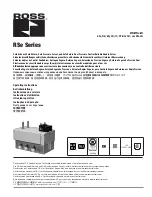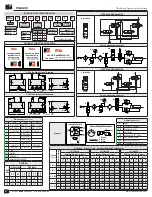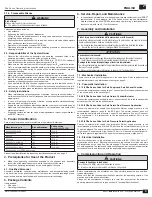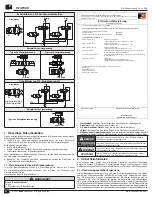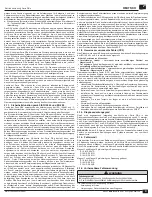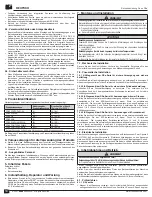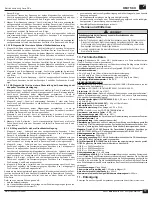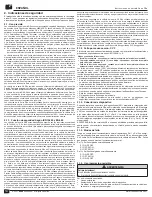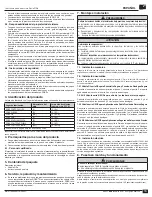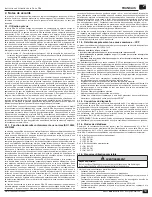
4
www.rosscontrols.com
© 2021,
ROSS
CONTROLS
®
.
All Rights Reserved.
RSe Series Operating Instructions
The safety function of the 5/2 RSe Series valve used for Safe Return Dual Pressure
applications is to drive a double-acting pneumatic actuator forward with pressure 1
when the two valve elements are actuated simultaneously and to drive the actuator
back with pressure 2 to its home “safe” position when both valve elements are
shut off or if only one of the two valves is actuated. A fault in the system where
only one valve actuates when switching on or only one de-actuates when shutting
off causes the RSe Series valve to supply pressure 1 from port 5 to port 4 of the
valve and to simultaneously open port 2 to exhaust (port 1). This, in turn, causes
the actuator to return to its home “safe” position. Monitoring of the two proximity
sensors by the user’s external safety monitoring system makes it possible to detect
these fault situations and to shut off and prevent further electrical energization of
the solenoids.
The safety function of the 5/2 RSe Series valve utilized for Safe Pressure Select
Applications in order to safely control the pressure applied to a machine operation,
such that a specified pressure is the default pressure and only when an appropriate
signal is given supplies a different pressure. The default pressure would be supplied
when both valves are shut off or if only one of the two valves is actuated. A fault in
the system where only one valve actuates when switching on or only one de-actuates
when switching off will supply the default pressure. Monitoring of the two proximity
sensors by the user’s external safety monitoring system makes it possible to detect
these fault situations and to shut off and prevent further electrical energization of the
solenoids.
The control outputs of the safety system must be designed and constructed to meet the
Category and/or Performance Level requirements of the safety system, as determined
by the risk assessment of the machine. Normally, the outputs to the solenoids is a
dual-channel output from a safety relay or safety PLC.
2.1.2. Common Cause Failure – CCF
The product has been engineered and manufactured according to the fundamental and
proven safety principles of ISO 1389-1 and -2.
Critical failure modes and causes:
•
Incomplete reversal - caused by incomplete return of solenoid valve B.
• Failure of the safety function - caused by simultaneous incomplete return of both
solenoid valves (A and B).
Common Cause Failures (CCF) are failures of different components, resulting from
a single event. CCF are not to be confused with cascading faults or common mode
faults. Common cause failures can cause loss of the safety function, especially in
dual channel circuits where both channels could fail simultaneously due to a single
event.
• Maintain compressed air quality, i.e., filtration, pressure regulation, lubrication.
• Avoid compressor oils that can cause valve seals to swell, soften, or otherwise
deteriorate.
• Operating outside of
prescribed temperature limits.
• Install the valve such that the normal stroke travel of the valve elements are
perpendicular to the main direction of machine vibration and/or mechanical shock.
• Do not use a test pulse longer than allowed by the Technical Specifications.
• Avoid external magnetic fields.
• Do not plug the valve exhaust port.
• Use only high-flow, non-clogging silencers, with similar or higher specifications as
ROSS
®
silencers.
2.1.3. Diagnostic Coverage
A diagnostic coverage of 99% is achievable through appropriate integration of the RSe
Series valve into the safety control system. The monitoring system must check for the
proper change of state of each valve sensor (S1 & S2) with each change of state of the
safety control system outputs to the valve solenoids (Sol 1 & Sol 2). Detection of a fault
by the safety control system must trigger a shut-off of the safety controller’s outputs to
the valve solenoids (Sol 1 & Sol 2). See section 8.
WARNING: On 5/2 versions, in the event of loss of pressure during a fault could cause
unexpected movement of a cylinder that is being controlled by the valve.
2.1.4. Fault Modes
Note that normal operation requires that Sol 1 & Sol 2 be energized simultaneously
for switching the RSe Series valve on, and de-energizing both Sol 1 and Sol 2
simultaneously for switching the RSe Series valve off. Faults that could occur during
normal operation:
Sol 1 & Sol 2 energized simultaneously
S1 ON, S2 OFF
S1 OFF, S2 ON
S1 OFF, S2 ON
Sol 1 & Sol 2 de-energized simultaneously
S1 ON, S2 OFF
S1 OFF, S2 ON
S1 ON, S2 OFF
ENGLISH
2. Notes on Safety
The product has been manufactured according to the accepted rules of current
technology.
There is risk of injury or damage if the following safety instructions and
warnings given in this instruction manual are not observed.
2.1. Intended Use
The RSe Series of double valves are safety components designed and manufactured
in accordance with Machinery Directive 2006/42/EC and bear the CE mark. The RSe
Series line of double valves are redundant 3/2 or 5/2 valves that are designed to meet
the needs and requirements of safe air supply/exhaust (3/2 valves) and Safe Return
Cylinder/Actuator (5/2 valves) applications for machinery with pneumatic controls. The
5/2 RSe Series valve can also be used for Safe Pressure Select or Safe Return Dual
Pressure applications. Typically, these valves are implemented to meet the Category
4 and/or Performance Level e requirements of a machine’s (or system’s) safety circuit
as determined by a risk assessment of the hazards and tasks required of employees
that interact with the machine/system.
f
See section 10 “Technical Data” for the standards and test values complied with
and adhered to by the product. See the declaration of comformity for product-
relevant EC directives.
The 3/2 RSe Series valve is designed to supply air to a zone or entire machine/system
until signaled to shut off and exhaust residual downstream pneumatic energy from the
machine. Thus, reducing the hazards associated with the presence of residual energy
during employee access and/or minor servicing. The safety function of the 3/2 RSe
Series valve is to shut off supply of pneumatic energy and to exhaust any pneumatic
energy from downstream of the valve. Note: The RSe Series valve cannot exhaust
pneumatic energy from downstream of obstructions such as check valves and closed
center function valves.
The 5/2 RSe Series valve is designed to control the direction of air flow into and out
of a double-acting cylinder or other pneumatic actuator in order to drive the cylinder
forward or backward to suit the requirements of the machine operation. However,
the RSe Series does this with the same level of control expected of the machine’s/
system’s safety circuit. The safety function of the RSe Series valve is to return the
cylinder/actuator to its home “safe” position whenever a fault occurs within the valve.
5/2 RSe Series valve can also be utilized for Dual Pressure Control applications in
order to extend a cylinder with pressure 1 and retract with pressure 2. The fail-to-safe
condition is always to supply pressure from port 5 to downstream port 4.
The 5/2 RSe Series valve can be utilized for Pressure Select Applications in order
to safely control the pressure applied to a machine operation, such that a specified
pressure is the default pressure and only when an appropriate signal is given will a
different pressure be supplied.
The RSe Series valves are designed for external monitoring for safe, redundant
operation of the valves. The RSe Series valves are constructed of redundant, 3/2 or
5/2 spool type valves, and have an overall function of a single solenoid pilot-operated,
spring return valve. Each single valve in the RSe Series is equipped with a PNP
proximity sensor. Monitoring both of these sensors on each actuation and de-actuation
of the RSe Series valve provides a diagnostic coverage up to 99%. Monitoring of
these sensors is to be done by an external monitoring system. Such a monitoring
system must be capable of inhibiting the operation of the valve.
2.1.1. Safety Function According to ISO 13849 and EN 692
RSe Series valves are designed in accordance with the requirements listed in ISO
13849-1 and -2. Their “fail-to-safe” safety function is ensured even in case of a fault
within the valve (e.g., caused by wear, contamination, or similar situations).
The safety function of the 3/2 RSe Series valve is to only supply compressed
air (pneumatic energy) to the machine/system when the two valve elements are
actuated simultaneously, but to shut-off the supply and to exhaust any downstream
compressed air when both valves are shut off or if only one of the two valves is
actuated. A fault in the system where only one valve actuates when switching
on or only one de-actuates when switching off prevents air from being supplied
downstream and simultaneously exhausts any air that is already downstream.
Monitoring of the two proximity sensors by the user’s external safety monitoring
system makes it possible to detect these fault situations and to shut off and prevent
further electrical energization of the solenoids.
The safety function of the 5/2 RSe Series valve is to drive a double-acting cylinder
or other pneumatic actuator forward when the two valve elements are actuated
simultaneously, but to drive the cylinder or other actuator back to its home “safe”
position when both valve elements are shut off or if only one of the two valves is
actuated. A fault in the system where only one valve actuates when switching on or
only one de-actuates when shutting off causes the RSe Series valve to supply air to
port 2 of the valve and to simultaneously open port 4 to exhaust (port 5). This, in turn,
causes the cylinder or other actuator to return to its home “safe” position. Monitoring
of the two proximity sensors by the user’s external safety monitoring system makes it
possible to detect these fault situations and to shut off and prevent further electrical
energization of the solenoids.

